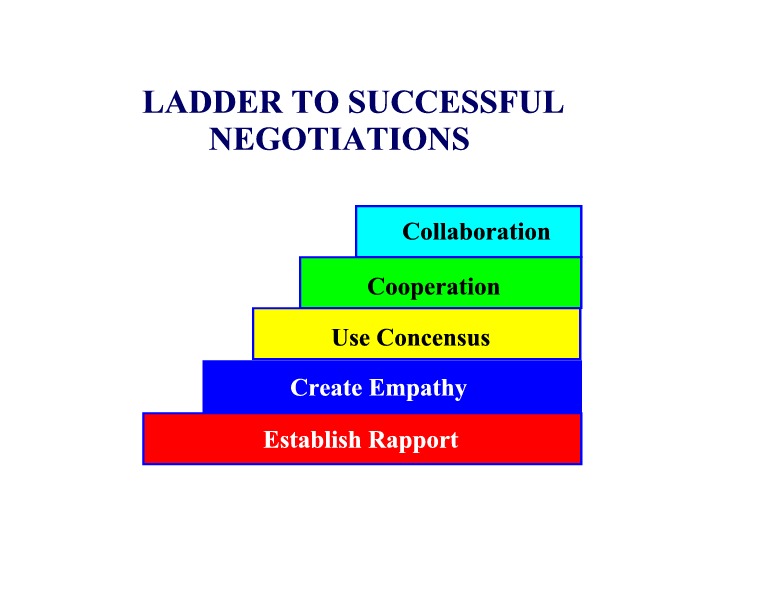| Five steps to a "Breakthrough Strategy" - Go to the Balcony
- Step to their Side
- Reframe
- Build them a goldenbridge
- Do not escalate- Use power to educate
Go to the Balcony - Suspend natural reactions- three common reactions:Striking back, Giving in, Breaking off
- Going to the balcony means distancing from your natural impulses and emotions- this will keep you focus on the ultimate goal-a deal that is better than your BATNA
- Some Tactics: Recognize the tactic, Know your buttons, Pause and Say Nothing, Rewind the tape, Take a time out, Do not make important decisions on the spot
Step to their Side - Stepping to their side means doing 3things: Listen to what the other party has to say, Acknowledge their point, their feelings and their competence and status, Agree with them whenever possible
- Listen Actively: Listening may be the cheapest concession you can make, Listening requires patience and Self-discipline, It is not enough just to listen, you must communicate that you have heard what the other said- Do this by pharaphrasing and asking for corrections.
- Acknowledge their point: Acknowledging does not mean agreeing with the other party's point, Acknowledging means that you view the otherside'spoint as one valid point of view among others
- Acknowledge their feelings: Behind anopponent's positions often lie emotions, Caution an insincere acknowledgment is easy to spot, Body language and tone count just as much as words, Offer an apology when necessary
- Agree whenever you can: Agree without conceding,Accumulate yeses to change relationship between the parties, Each yes reduces tension
Reframe - Reframing works because every message is subject to interpretation
- You have the power of positive perception-the ability to put a problem-solving frame around whatever the other side says
- Reframing Techniques: Askproblemsolvingquestions-"why?";"why not?";"what if?", Ask for the other party's advice, Ask "what makes that fair/", Use open-ended questions, Tap the power of silence, Deflect attacks by changing it to an attack on the problem, Expose tricks
Build them the Golden Bridge - Instead of pushing the other side toward an agreement, you need to reframe are treat from their position as an advance toward a better solution
- Start where the other side is in order to guide them toward eventual agreement
- Building a golden bridge makes it easier for the other side to surmount the four common obstacles to agreement:Not their idea, Unmet interests, Fear of losing face, Too much, too fast
- Involvetheotherside: Ask for and build on the other side's ideas, Ask for constructive criticism, Offer them a choice
- Satisfy unmet needs: Resistance often stems from unmet needs, Do not dismiss needs as irrational, Do not over look basic human needs, Do not assume a fixed pie: Look for low-cost, high-benefit trades, Use an if-them formula
- Help the other side save face: Help them back away without backing down, Show how circumstances have changed, Ask for third party recommendation, Point to a standard of fairness
- Do not rush to the finish.
Do not escalate:Use power to educate - Often,when negotiations are frustrating, parties switch from problems solving game to apower game
- Use power to educate that only way for them to win is for both sides to win: Let them know the consequences, Ask reality-testing questions such as: "what do you think will happen if we do not agree?", "what do you think I wil do?", "What will you do?"
- Warn, do not threaten
- Demonstrate your BATNA
- Remind opponent of the Golden Bridge
Forge a lasting agreement - Do not ignore implementation
- Design deal to minimize risks
- Build in dispute resolution procedures

|
|


